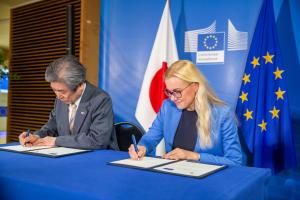Europe-Japan
An even Broader Approach
9 Mar 2020
-
Anri Kato
On 2 March, the European Atomic Energy Community (Euratom) and the Japanese government signed a joint declaration for the second phase of the Broader Approach activities, agreeing on further cooperation on research and development in the field of fusion energy.
Kazuo Kodama, the Ambassador Extraordinary and Plenipotentiary of Japan to the European Union, and Energy Commissioner Kadri Simson, representing the European Atomic Energy Community (Euratom), sign the joint declaration on the Broader Approach activities on 2 March.
"The ITER Organization welcomes this extension of the Euratom-Japan collaboration on ITER Broader Approach activities, which support and complement the ITER Project. It will help to intensify the cooperation between two of the major partners of the project in technical domains of relevance to ITER," said ITER Director-General Bernard Bigot.
Signed in 2007, the Broader Approach agreement set into motion three projects, all located in Japan, with the joint investment of Euratom and the government of Japan (represented by its Ministry of Education, Culture, Sports, Science and Technology, MEXT). Since then, the agreement has been developed collaboratively by its implementing agencies Fusion for Energy and the National Institutes for Quantum and Radiological Science and Technology (QST).
One of the Broader Approach projects, the JT-60SA tokamak, will be the largest tokamak in the world when it begins operating this year. The team based in Naka will conduct research on key physics issues for ITER and DEMO such as the development of optimized operational regimes; questions of stability and control, transport and confinement, and high-energy particle behaviour; pedestal and edge physics; plasma-material interaction; fusion engineering; and theoretical models and simulation codes.
Even before then, however, the experience of assembling, installing, commissioning and starting up JT-60SA will be highly valuable for the ITER Organization. Ensuring that ITER fully benefits from JT-60SA returns on experience was the objective of a trilateral arrangement signed last November between the ITER Organization and the Broader Approach implementing agencies. The collaboration arrangement foresees the exchange of data and information; the exchange of scientists, engineers and other technical experts; the exchange of equipment, materials and instrumentation; and jointly performed experimentation, including remote participation.
Phase II of the Broader Approach projects will focus on the operation and exploitation of the three projects that have been established, to the benefit of both parties. The teams will also be cooperating more closely than ever with ITER as the project advances steadily towards First Plasma in 2025.
For more information on the Broader Approach, see this brochure edited by the European Commission or the QST website for information in Japanese.


